Advanced Financial Accounting Report: Impairment Testing of Assets
VerifiedAdded on 2020/05/28
|14
|3078
|71
Report
AI Summary
This report provides a comprehensive analysis of asset impairment in advanced financial accounting, using M2 Telecommunications Group Limited's 2015 annual report as a case study. It examines the company's impairment testing processes for various asset classes, including intangible assets, goodwill, trade receivables, and property, plant, and equipment. The report delves into the two-step impairment testing technique, assumptions, and subjectivity involved, highlighting the impact of IFRS 36 and the potential for opportunistic management discretion. Furthermore, it explores the concepts of fair value and value-in-use in determining impairment loss and discusses the implications of new accounting standards, particularly regarding lease accounting, US GAAP, and IFRS, and their impact on financial reporting and comparability. The analysis also covers the challenges and controversies associated with changes in accounting standards, emphasizing the need for businesses to adapt and consider the broad commercial implications of such changes.
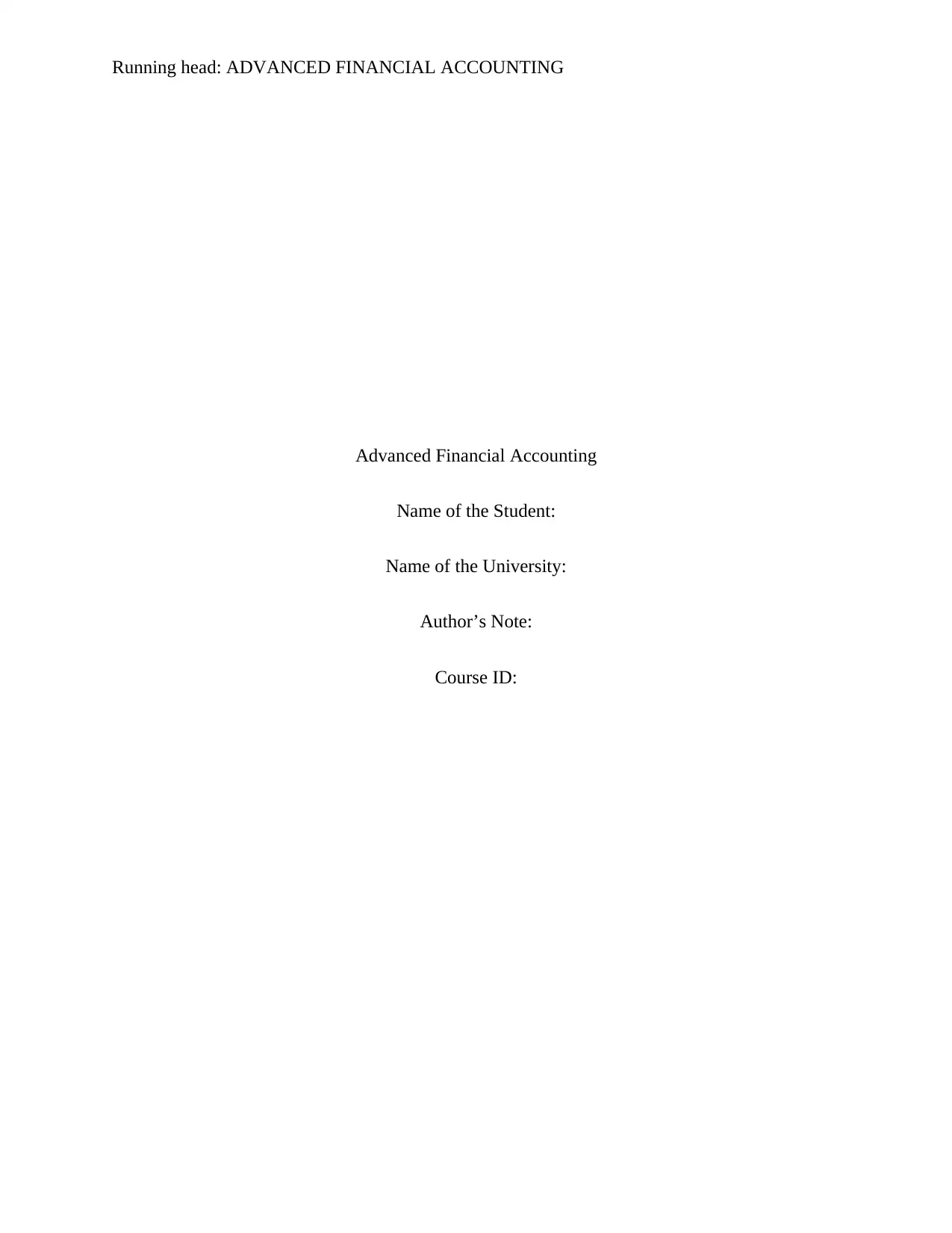
Running head: ADVANCED FINANCIAL ACCOUNTING
Advanced Financial Accounting
Name of the Student:
Name of the University:
Author’s Note:
Course ID:
Advanced Financial Accounting
Name of the Student:
Name of the University:
Author’s Note:
Course ID:
Paraphrase This Document
Need a fresh take? Get an instant paraphrase of this document with our AI Paraphraser
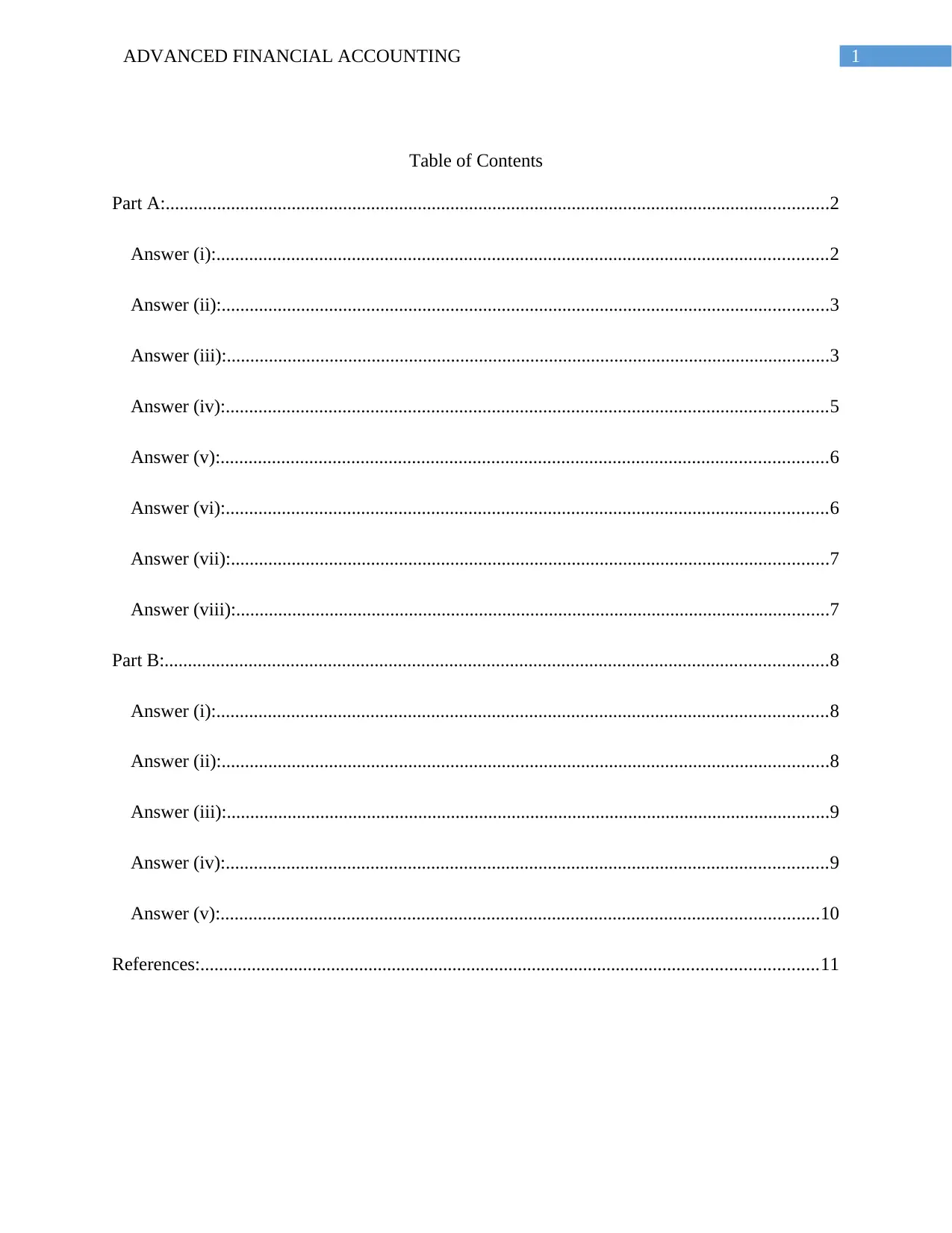
1ADVANCED FINANCIAL ACCOUNTING
Table of Contents
Part A:..............................................................................................................................................2
Answer (i):...................................................................................................................................2
Answer (ii):..................................................................................................................................3
Answer (iii):.................................................................................................................................3
Answer (iv):.................................................................................................................................5
Answer (v):..................................................................................................................................6
Answer (vi):.................................................................................................................................6
Answer (vii):................................................................................................................................7
Answer (viii):...............................................................................................................................7
Part B:..............................................................................................................................................8
Answer (i):...................................................................................................................................8
Answer (ii):..................................................................................................................................8
Answer (iii):.................................................................................................................................9
Answer (iv):.................................................................................................................................9
Answer (v):................................................................................................................................10
References:....................................................................................................................................11
Table of Contents
Part A:..............................................................................................................................................2
Answer (i):...................................................................................................................................2
Answer (ii):..................................................................................................................................3
Answer (iii):.................................................................................................................................3
Answer (iv):.................................................................................................................................5
Answer (v):..................................................................................................................................6
Answer (vi):.................................................................................................................................6
Answer (vii):................................................................................................................................7
Answer (viii):...............................................................................................................................7
Part B:..............................................................................................................................................8
Answer (i):...................................................................................................................................8
Answer (ii):..................................................................................................................................8
Answer (iii):.................................................................................................................................9
Answer (iv):.................................................................................................................................9
Answer (v):................................................................................................................................10
References:....................................................................................................................................11
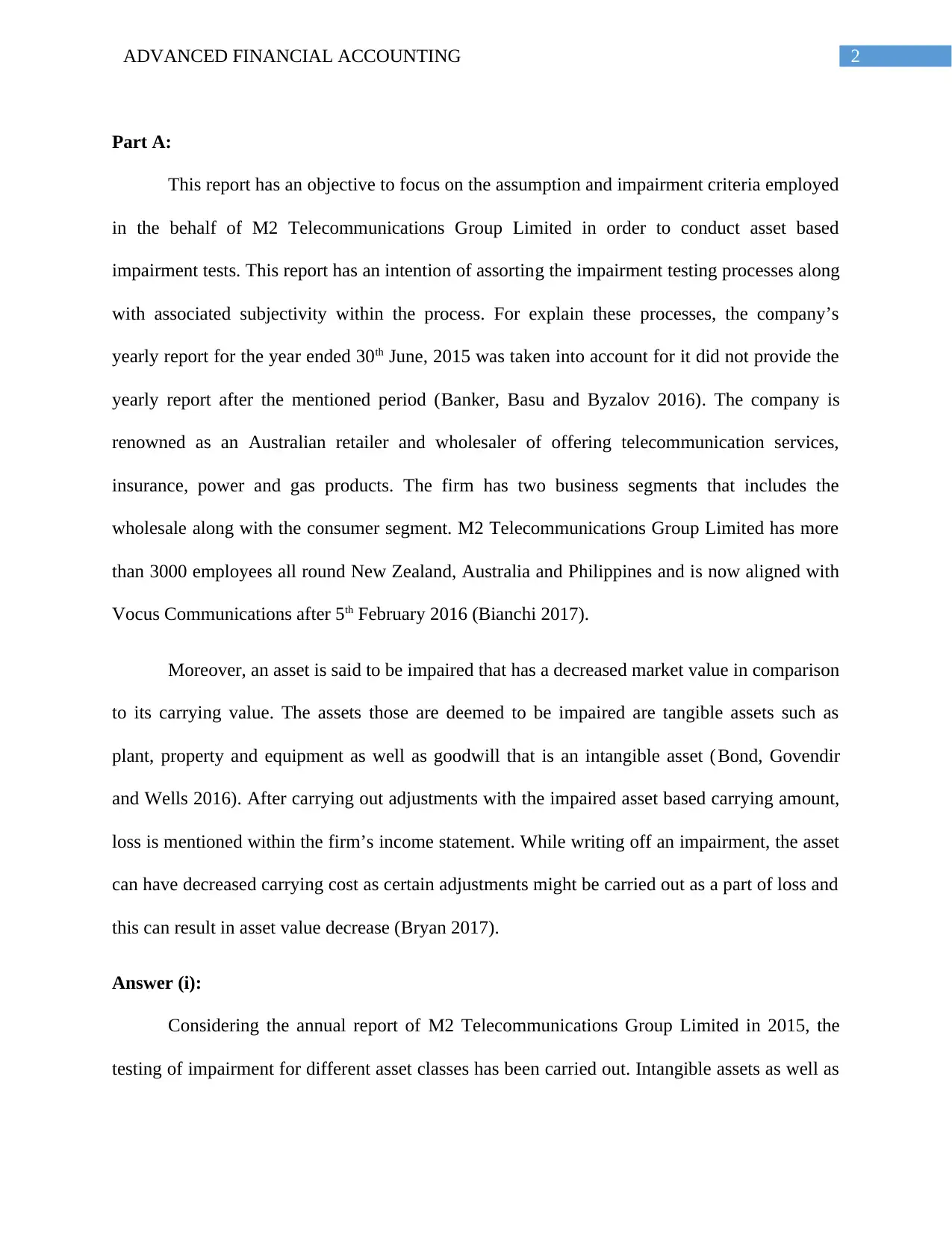
2ADVANCED FINANCIAL ACCOUNTING
Part A:
This report has an objective to focus on the assumption and impairment criteria employed
in the behalf of M2 Telecommunications Group Limited in order to conduct asset based
impairment tests. This report has an intention of assorting the impairment testing processes along
with associated subjectivity within the process. For explain these processes, the company’s
yearly report for the year ended 30th June, 2015 was taken into account for it did not provide the
yearly report after the mentioned period (Banker, Basu and Byzalov 2016). The company is
renowned as an Australian retailer and wholesaler of offering telecommunication services,
insurance, power and gas products. The firm has two business segments that includes the
wholesale along with the consumer segment. M2 Telecommunications Group Limited has more
than 3000 employees all round New Zealand, Australia and Philippines and is now aligned with
Vocus Communications after 5th February 2016 (Bianchi 2017).
Moreover, an asset is said to be impaired that has a decreased market value in comparison
to its carrying value. The assets those are deemed to be impaired are tangible assets such as
plant, property and equipment as well as goodwill that is an intangible asset (Bond, Govendir
and Wells 2016). After carrying out adjustments with the impaired asset based carrying amount,
loss is mentioned within the firm’s income statement. While writing off an impairment, the asset
can have decreased carrying cost as certain adjustments might be carried out as a part of loss and
this can result in asset value decrease (Bryan 2017).
Answer (i):
Considering the annual report of M2 Telecommunications Group Limited in 2015, the
testing of impairment for different asset classes has been carried out. Intangible assets as well as
Part A:
This report has an objective to focus on the assumption and impairment criteria employed
in the behalf of M2 Telecommunications Group Limited in order to conduct asset based
impairment tests. This report has an intention of assorting the impairment testing processes along
with associated subjectivity within the process. For explain these processes, the company’s
yearly report for the year ended 30th June, 2015 was taken into account for it did not provide the
yearly report after the mentioned period (Banker, Basu and Byzalov 2016). The company is
renowned as an Australian retailer and wholesaler of offering telecommunication services,
insurance, power and gas products. The firm has two business segments that includes the
wholesale along with the consumer segment. M2 Telecommunications Group Limited has more
than 3000 employees all round New Zealand, Australia and Philippines and is now aligned with
Vocus Communications after 5th February 2016 (Bianchi 2017).
Moreover, an asset is said to be impaired that has a decreased market value in comparison
to its carrying value. The assets those are deemed to be impaired are tangible assets such as
plant, property and equipment as well as goodwill that is an intangible asset (Bond, Govendir
and Wells 2016). After carrying out adjustments with the impaired asset based carrying amount,
loss is mentioned within the firm’s income statement. While writing off an impairment, the asset
can have decreased carrying cost as certain adjustments might be carried out as a part of loss and
this can result in asset value decrease (Bryan 2017).
Answer (i):
Considering the annual report of M2 Telecommunications Group Limited in 2015, the
testing of impairment for different asset classes has been carried out. Intangible assets as well as
⊘ This is a preview!⊘
Do you want full access?
Subscribe today to unlock all pages.

Trusted by 1+ million students worldwide
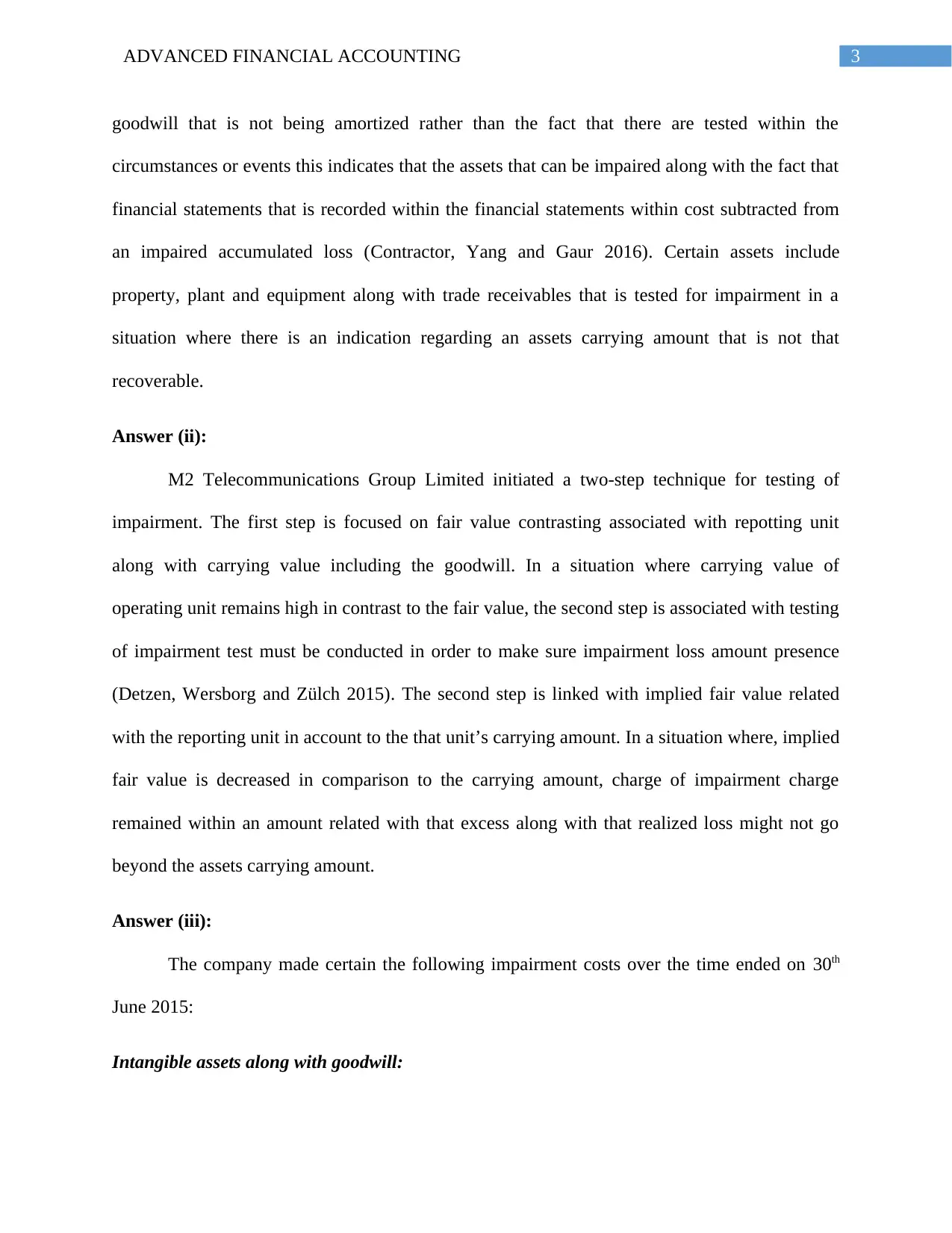
3ADVANCED FINANCIAL ACCOUNTING
goodwill that is not being amortized rather than the fact that there are tested within the
circumstances or events this indicates that the assets that can be impaired along with the fact that
financial statements that is recorded within the financial statements within cost subtracted from
an impaired accumulated loss (Contractor, Yang and Gaur 2016). Certain assets include
property, plant and equipment along with trade receivables that is tested for impairment in a
situation where there is an indication regarding an assets carrying amount that is not that
recoverable.
Answer (ii):
M2 Telecommunications Group Limited initiated a two-step technique for testing of
impairment. The first step is focused on fair value contrasting associated with repotting unit
along with carrying value including the goodwill. In a situation where carrying value of
operating unit remains high in contrast to the fair value, the second step is associated with testing
of impairment test must be conducted in order to make sure impairment loss amount presence
(Detzen, Wersborg and Zülch 2015). The second step is linked with implied fair value related
with the reporting unit in account to the that unit’s carrying amount. In a situation where, implied
fair value is decreased in comparison to the carrying amount, charge of impairment charge
remained within an amount related with that excess along with that realized loss might not go
beyond the assets carrying amount.
Answer (iii):
The company made certain the following impairment costs over the time ended on 30th
June 2015:
Intangible assets along with goodwill:
goodwill that is not being amortized rather than the fact that there are tested within the
circumstances or events this indicates that the assets that can be impaired along with the fact that
financial statements that is recorded within the financial statements within cost subtracted from
an impaired accumulated loss (Contractor, Yang and Gaur 2016). Certain assets include
property, plant and equipment along with trade receivables that is tested for impairment in a
situation where there is an indication regarding an assets carrying amount that is not that
recoverable.
Answer (ii):
M2 Telecommunications Group Limited initiated a two-step technique for testing of
impairment. The first step is focused on fair value contrasting associated with repotting unit
along with carrying value including the goodwill. In a situation where carrying value of
operating unit remains high in contrast to the fair value, the second step is associated with testing
of impairment test must be conducted in order to make sure impairment loss amount presence
(Detzen, Wersborg and Zülch 2015). The second step is linked with implied fair value related
with the reporting unit in account to the that unit’s carrying amount. In a situation where, implied
fair value is decreased in comparison to the carrying amount, charge of impairment charge
remained within an amount related with that excess along with that realized loss might not go
beyond the assets carrying amount.
Answer (iii):
The company made certain the following impairment costs over the time ended on 30th
June 2015:
Intangible assets along with goodwill:
Paraphrase This Document
Need a fresh take? Get an instant paraphrase of this document with our AI Paraphraser
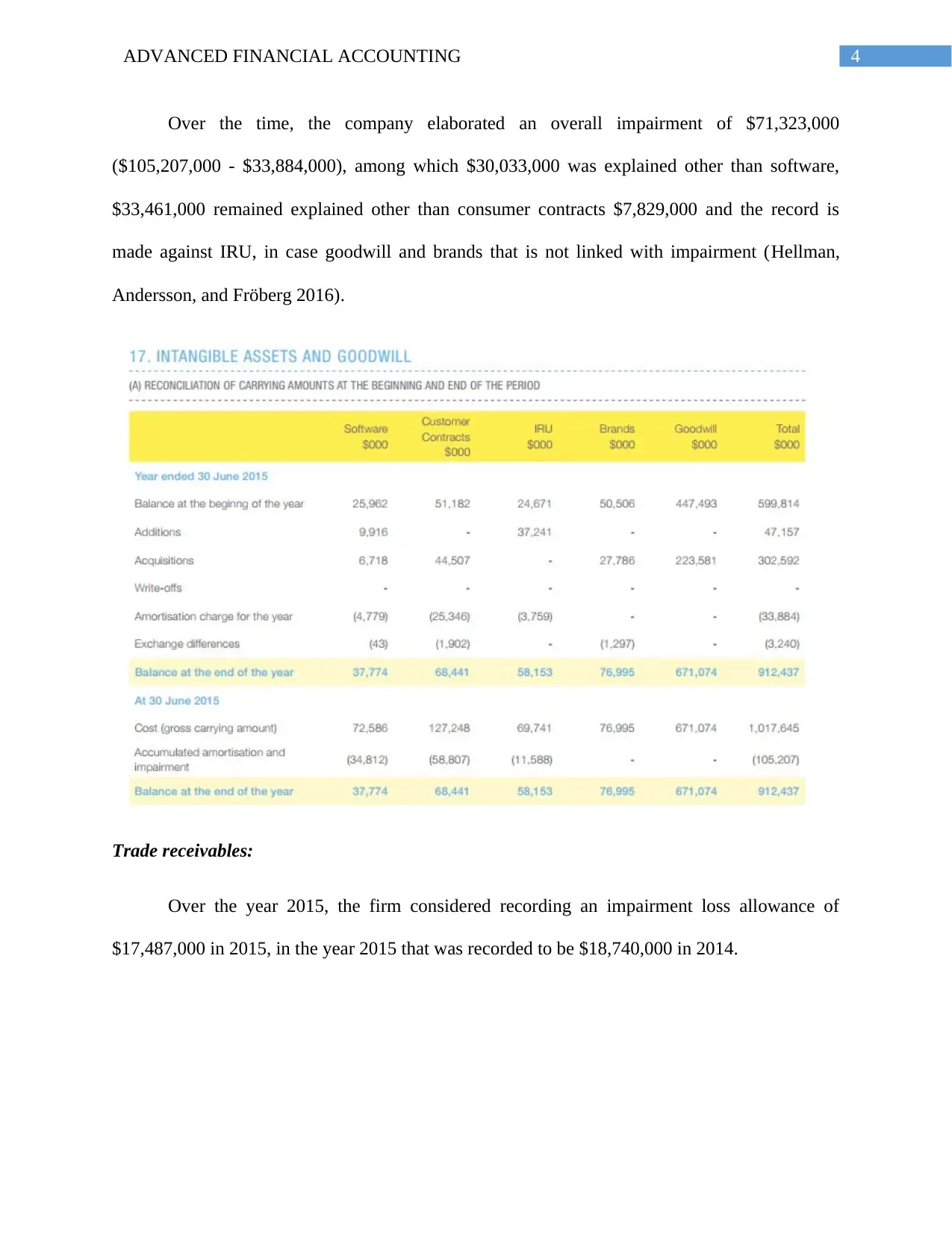
4ADVANCED FINANCIAL ACCOUNTING
Over the time, the company elaborated an overall impairment of $71,323,000
($105,207,000 - $33,884,000), among which $30,033,000 was explained other than software,
$33,461,000 remained explained other than consumer contracts $7,829,000 and the record is
made against IRU, in case goodwill and brands that is not linked with impairment (Hellman,
Andersson, and Fröberg 2016).
Trade receivables:
Over the year 2015, the firm considered recording an impairment loss allowance of
$17,487,000 in 2015, in the year 2015 that was recorded to be $18,740,000 in 2014.
Over the time, the company elaborated an overall impairment of $71,323,000
($105,207,000 - $33,884,000), among which $30,033,000 was explained other than software,
$33,461,000 remained explained other than consumer contracts $7,829,000 and the record is
made against IRU, in case goodwill and brands that is not linked with impairment (Hellman,
Andersson, and Fröberg 2016).
Trade receivables:
Over the year 2015, the firm considered recording an impairment loss allowance of
$17,487,000 in 2015, in the year 2015 that was recorded to be $18,740,000 in 2014.
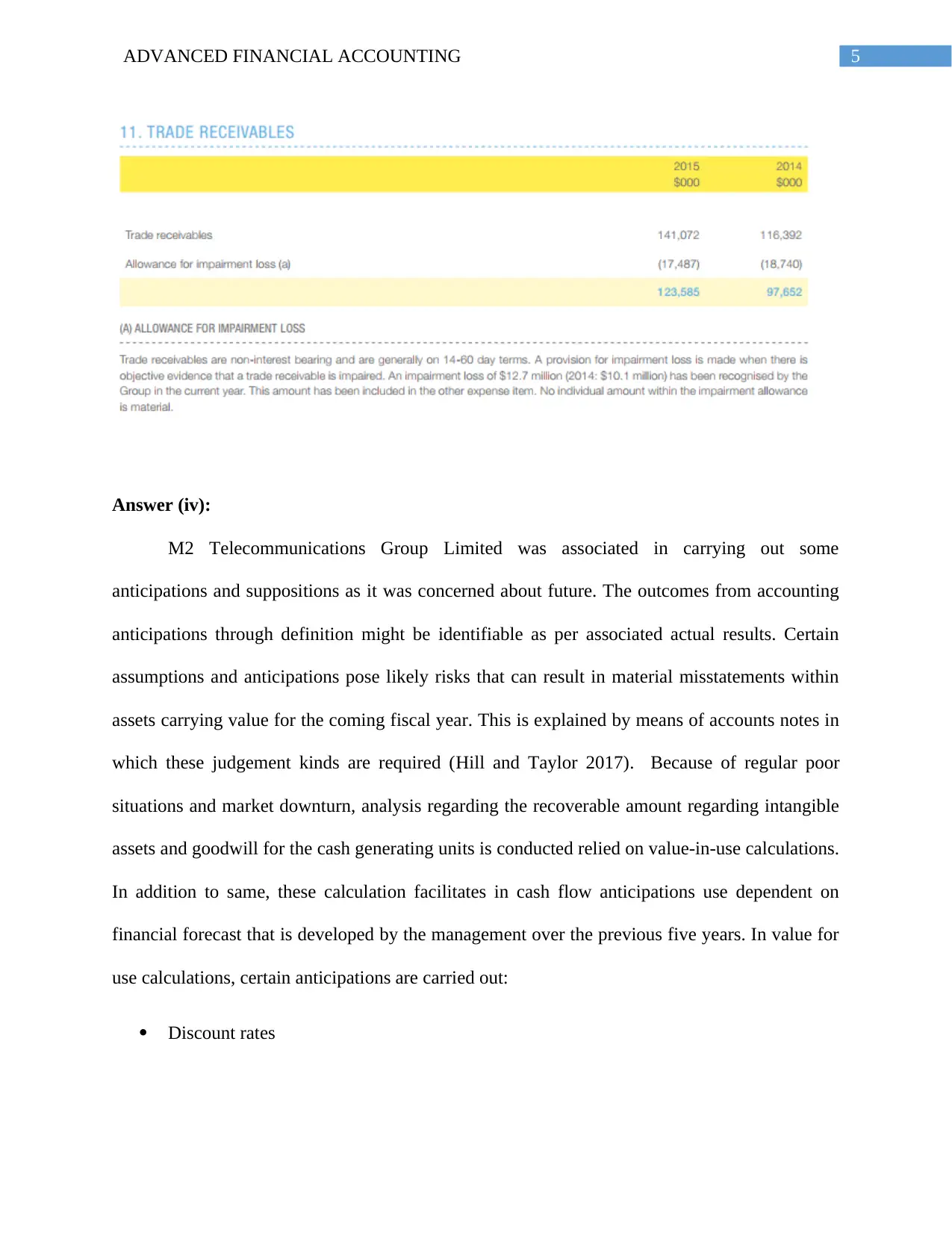
5ADVANCED FINANCIAL ACCOUNTING
Answer (iv):
M2 Telecommunications Group Limited was associated in carrying out some
anticipations and suppositions as it was concerned about future. The outcomes from accounting
anticipations through definition might be identifiable as per associated actual results. Certain
assumptions and anticipations pose likely risks that can result in material misstatements within
assets carrying value for the coming fiscal year. This is explained by means of accounts notes in
which these judgement kinds are required (Hill and Taylor 2017). Because of regular poor
situations and market downturn, analysis regarding the recoverable amount regarding intangible
assets and goodwill for the cash generating units is conducted relied on value-in-use calculations.
In addition to same, these calculation facilitates in cash flow anticipations use dependent on
financial forecast that is developed by the management over the previous five years. In value for
use calculations, certain anticipations are carried out:
Discount rates
Answer (iv):
M2 Telecommunications Group Limited was associated in carrying out some
anticipations and suppositions as it was concerned about future. The outcomes from accounting
anticipations through definition might be identifiable as per associated actual results. Certain
assumptions and anticipations pose likely risks that can result in material misstatements within
assets carrying value for the coming fiscal year. This is explained by means of accounts notes in
which these judgement kinds are required (Hill and Taylor 2017). Because of regular poor
situations and market downturn, analysis regarding the recoverable amount regarding intangible
assets and goodwill for the cash generating units is conducted relied on value-in-use calculations.
In addition to same, these calculation facilitates in cash flow anticipations use dependent on
financial forecast that is developed by the management over the previous five years. In value for
use calculations, certain anticipations are carried out:
Discount rates
⊘ This is a preview!⊘
Do you want full access?
Subscribe today to unlock all pages.

Trusted by 1+ million students worldwide
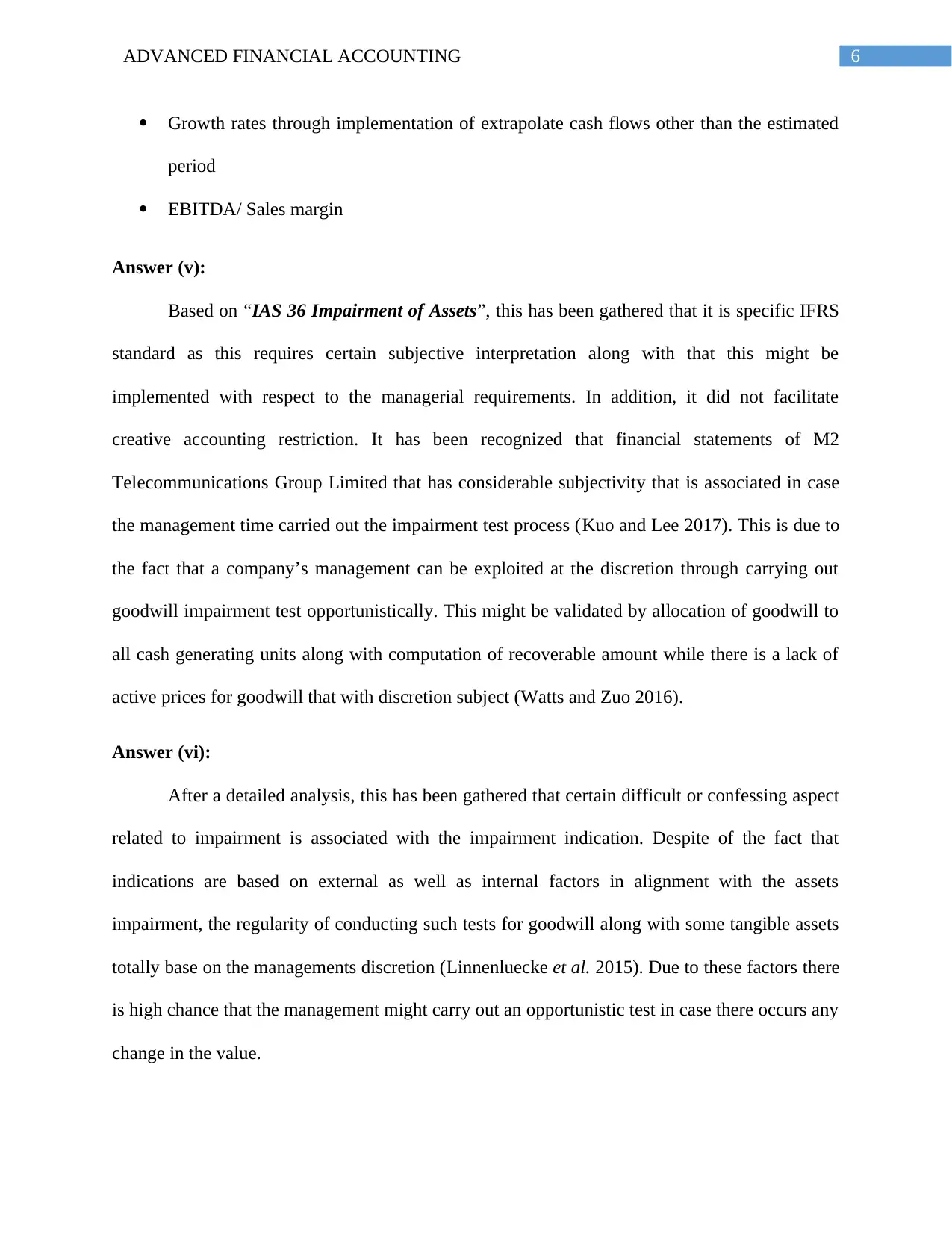
6ADVANCED FINANCIAL ACCOUNTING
Growth rates through implementation of extrapolate cash flows other than the estimated
period
EBITDA/ Sales margin
Answer (v):
Based on “IAS 36 Impairment of Assets”, this has been gathered that it is specific IFRS
standard as this requires certain subjective interpretation along with that this might be
implemented with respect to the managerial requirements. In addition, it did not facilitate
creative accounting restriction. It has been recognized that financial statements of M2
Telecommunications Group Limited that has considerable subjectivity that is associated in case
the management time carried out the impairment test process (Kuo and Lee 2017). This is due to
the fact that a company’s management can be exploited at the discretion through carrying out
goodwill impairment test opportunistically. This might be validated by allocation of goodwill to
all cash generating units along with computation of recoverable amount while there is a lack of
active prices for goodwill that with discretion subject (Watts and Zuo 2016).
Answer (vi):
After a detailed analysis, this has been gathered that certain difficult or confessing aspect
related to impairment is associated with the impairment indication. Despite of the fact that
indications are based on external as well as internal factors in alignment with the assets
impairment, the regularity of conducting such tests for goodwill along with some tangible assets
totally base on the managements discretion (Linnenluecke et al. 2015). Due to these factors there
is high chance that the management might carry out an opportunistic test in case there occurs any
change in the value.
Growth rates through implementation of extrapolate cash flows other than the estimated
period
EBITDA/ Sales margin
Answer (v):
Based on “IAS 36 Impairment of Assets”, this has been gathered that it is specific IFRS
standard as this requires certain subjective interpretation along with that this might be
implemented with respect to the managerial requirements. In addition, it did not facilitate
creative accounting restriction. It has been recognized that financial statements of M2
Telecommunications Group Limited that has considerable subjectivity that is associated in case
the management time carried out the impairment test process (Kuo and Lee 2017). This is due to
the fact that a company’s management can be exploited at the discretion through carrying out
goodwill impairment test opportunistically. This might be validated by allocation of goodwill to
all cash generating units along with computation of recoverable amount while there is a lack of
active prices for goodwill that with discretion subject (Watts and Zuo 2016).
Answer (vi):
After a detailed analysis, this has been gathered that certain difficult or confessing aspect
related to impairment is associated with the impairment indication. Despite of the fact that
indications are based on external as well as internal factors in alignment with the assets
impairment, the regularity of conducting such tests for goodwill along with some tangible assets
totally base on the managements discretion (Linnenluecke et al. 2015). Due to these factors there
is high chance that the management might carry out an opportunistic test in case there occurs any
change in the value.
Paraphrase This Document
Need a fresh take? Get an instant paraphrase of this document with our AI Paraphraser
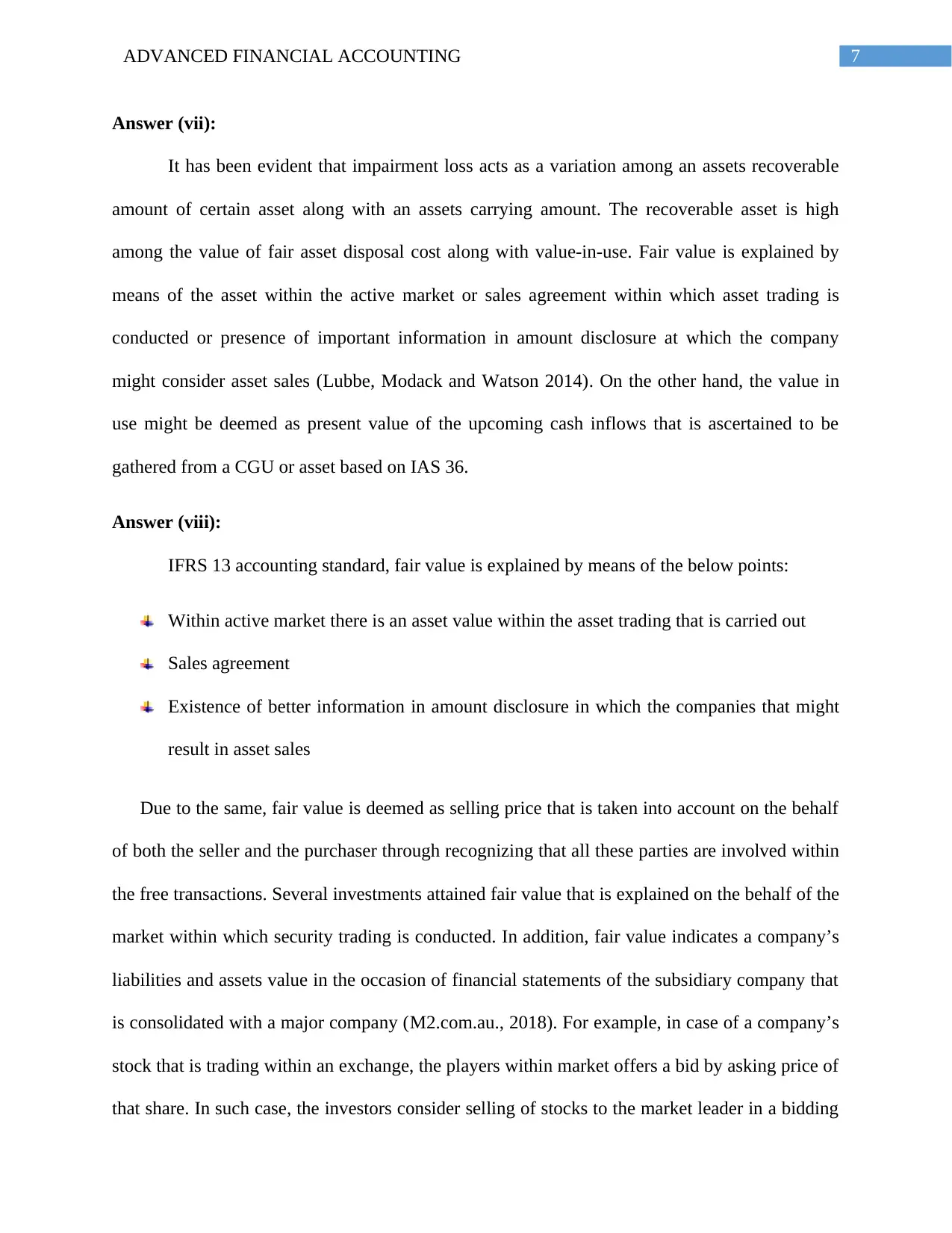
7ADVANCED FINANCIAL ACCOUNTING
Answer (vii):
It has been evident that impairment loss acts as a variation among an assets recoverable
amount of certain asset along with an assets carrying amount. The recoverable asset is high
among the value of fair asset disposal cost along with value-in-use. Fair value is explained by
means of the asset within the active market or sales agreement within which asset trading is
conducted or presence of important information in amount disclosure at which the company
might consider asset sales (Lubbe, Modack and Watson 2014). On the other hand, the value in
use might be deemed as present value of the upcoming cash inflows that is ascertained to be
gathered from a CGU or asset based on IAS 36.
Answer (viii):
IFRS 13 accounting standard, fair value is explained by means of the below points:
Within active market there is an asset value within the asset trading that is carried out
Sales agreement
Existence of better information in amount disclosure in which the companies that might
result in asset sales
Due to the same, fair value is deemed as selling price that is taken into account on the behalf
of both the seller and the purchaser through recognizing that all these parties are involved within
the free transactions. Several investments attained fair value that is explained on the behalf of the
market within which security trading is conducted. In addition, fair value indicates a company’s
liabilities and assets value in the occasion of financial statements of the subsidiary company that
is consolidated with a major company (M2.com.au., 2018). For example, in case of a company’s
stock that is trading within an exchange, the players within market offers a bid by asking price of
that share. In such case, the investors consider selling of stocks to the market leader in a bidding
Answer (vii):
It has been evident that impairment loss acts as a variation among an assets recoverable
amount of certain asset along with an assets carrying amount. The recoverable asset is high
among the value of fair asset disposal cost along with value-in-use. Fair value is explained by
means of the asset within the active market or sales agreement within which asset trading is
conducted or presence of important information in amount disclosure at which the company
might consider asset sales (Lubbe, Modack and Watson 2014). On the other hand, the value in
use might be deemed as present value of the upcoming cash inflows that is ascertained to be
gathered from a CGU or asset based on IAS 36.
Answer (viii):
IFRS 13 accounting standard, fair value is explained by means of the below points:
Within active market there is an asset value within the asset trading that is carried out
Sales agreement
Existence of better information in amount disclosure in which the companies that might
result in asset sales
Due to the same, fair value is deemed as selling price that is taken into account on the behalf
of both the seller and the purchaser through recognizing that all these parties are involved within
the free transactions. Several investments attained fair value that is explained on the behalf of the
market within which security trading is conducted. In addition, fair value indicates a company’s
liabilities and assets value in the occasion of financial statements of the subsidiary company that
is consolidated with a major company (M2.com.au., 2018). For example, in case of a company’s
stock that is trading within an exchange, the players within market offers a bid by asking price of
that share. In such case, the investors consider selling of stocks to the market leader in a bidding
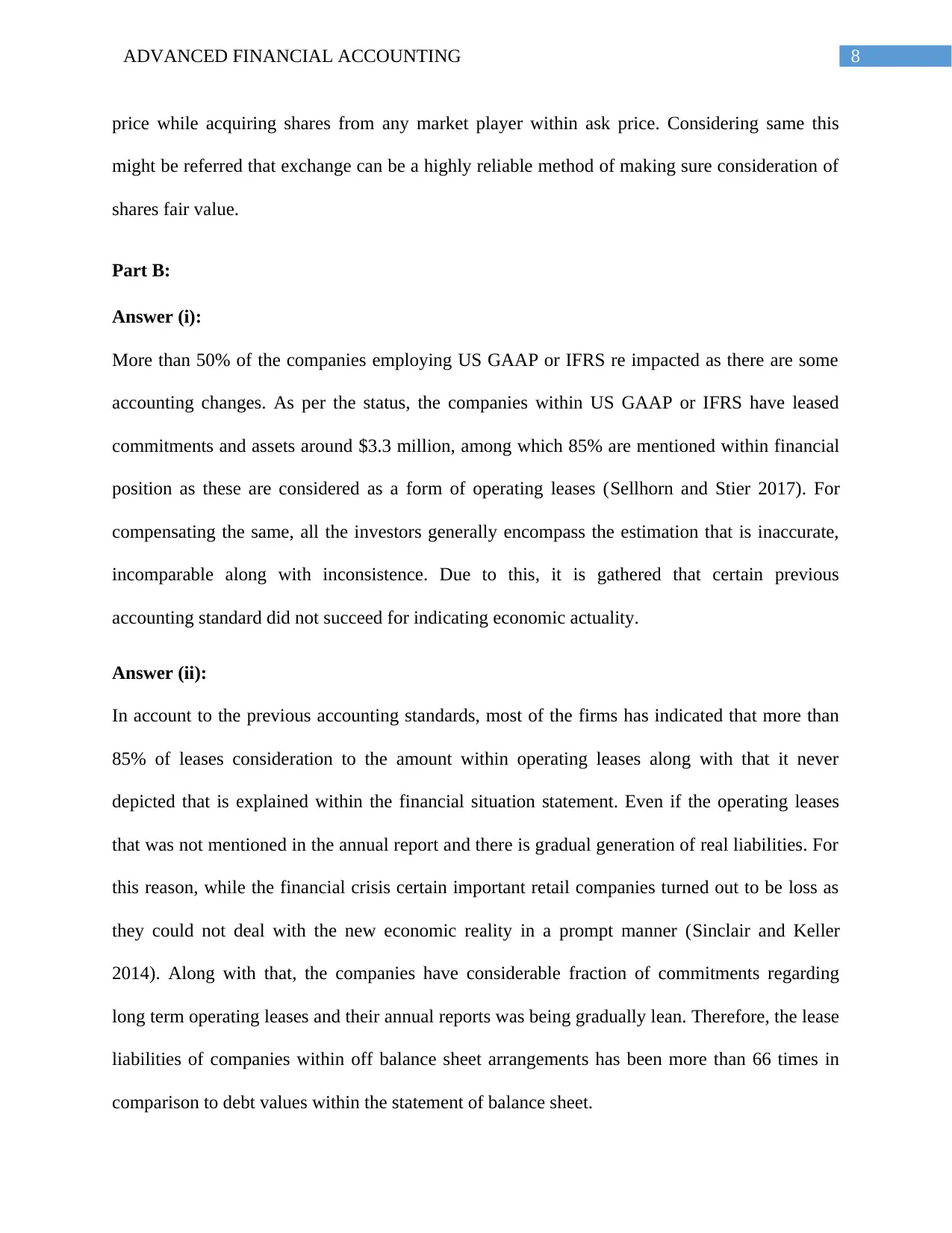
8ADVANCED FINANCIAL ACCOUNTING
price while acquiring shares from any market player within ask price. Considering same this
might be referred that exchange can be a highly reliable method of making sure consideration of
shares fair value.
Part B:
Answer (i):
More than 50% of the companies employing US GAAP or IFRS re impacted as there are some
accounting changes. As per the status, the companies within US GAAP or IFRS have leased
commitments and assets around $3.3 million, among which 85% are mentioned within financial
position as these are considered as a form of operating leases (Sellhorn and Stier 2017). For
compensating the same, all the investors generally encompass the estimation that is inaccurate,
incomparable along with inconsistence. Due to this, it is gathered that certain previous
accounting standard did not succeed for indicating economic actuality.
Answer (ii):
In account to the previous accounting standards, most of the firms has indicated that more than
85% of leases consideration to the amount within operating leases along with that it never
depicted that is explained within the financial situation statement. Even if the operating leases
that was not mentioned in the annual report and there is gradual generation of real liabilities. For
this reason, while the financial crisis certain important retail companies turned out to be loss as
they could not deal with the new economic reality in a prompt manner (Sinclair and Keller
2014). Along with that, the companies have considerable fraction of commitments regarding
long term operating leases and their annual reports was being gradually lean. Therefore, the lease
liabilities of companies within off balance sheet arrangements has been more than 66 times in
comparison to debt values within the statement of balance sheet.
price while acquiring shares from any market player within ask price. Considering same this
might be referred that exchange can be a highly reliable method of making sure consideration of
shares fair value.
Part B:
Answer (i):
More than 50% of the companies employing US GAAP or IFRS re impacted as there are some
accounting changes. As per the status, the companies within US GAAP or IFRS have leased
commitments and assets around $3.3 million, among which 85% are mentioned within financial
position as these are considered as a form of operating leases (Sellhorn and Stier 2017). For
compensating the same, all the investors generally encompass the estimation that is inaccurate,
incomparable along with inconsistence. Due to this, it is gathered that certain previous
accounting standard did not succeed for indicating economic actuality.
Answer (ii):
In account to the previous accounting standards, most of the firms has indicated that more than
85% of leases consideration to the amount within operating leases along with that it never
depicted that is explained within the financial situation statement. Even if the operating leases
that was not mentioned in the annual report and there is gradual generation of real liabilities. For
this reason, while the financial crisis certain important retail companies turned out to be loss as
they could not deal with the new economic reality in a prompt manner (Sinclair and Keller
2014). Along with that, the companies have considerable fraction of commitments regarding
long term operating leases and their annual reports was being gradually lean. Therefore, the lease
liabilities of companies within off balance sheet arrangements has been more than 66 times in
comparison to debt values within the statement of balance sheet.
⊘ This is a preview!⊘
Do you want full access?
Subscribe today to unlock all pages.

Trusted by 1+ million students worldwide
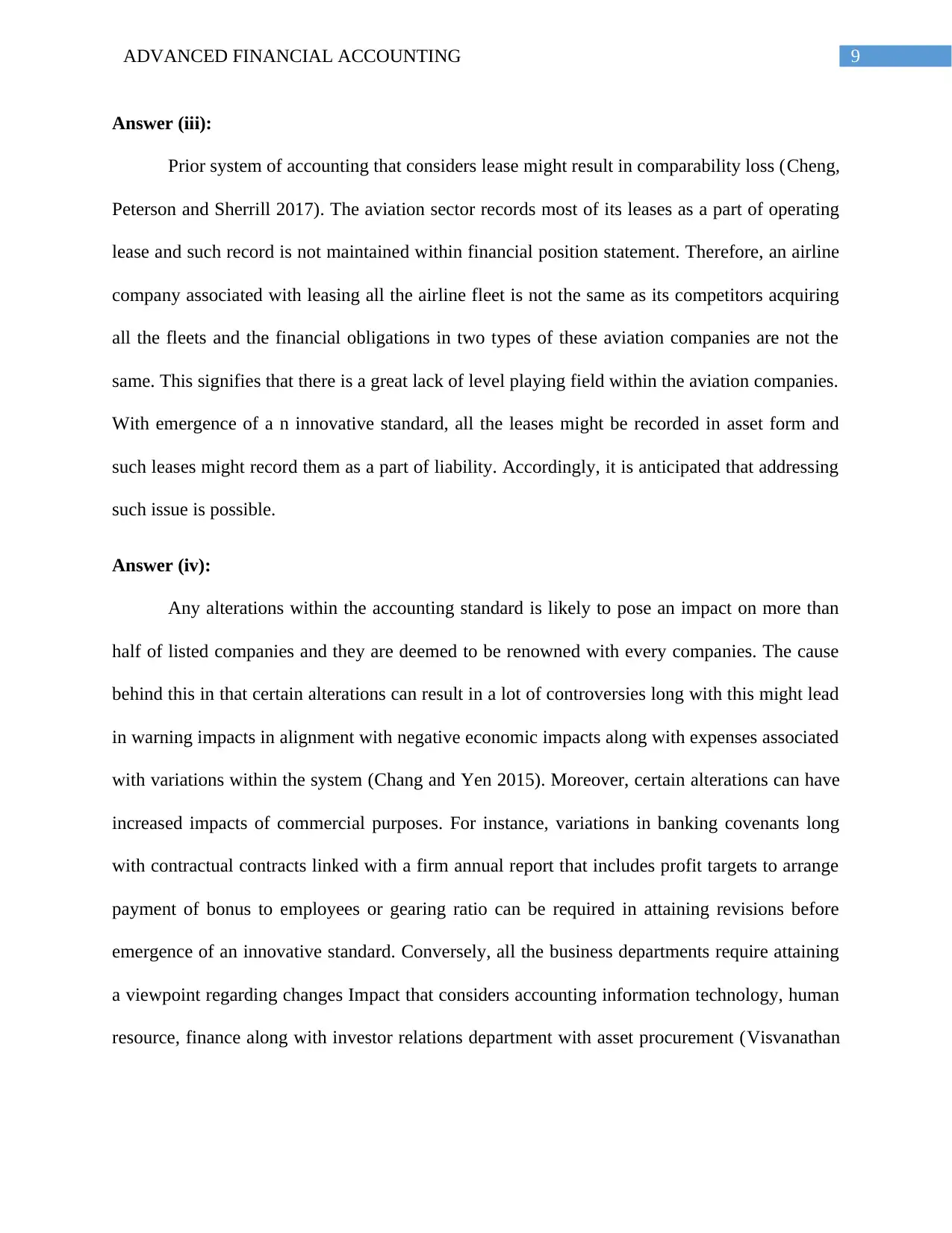
9ADVANCED FINANCIAL ACCOUNTING
Answer (iii):
Prior system of accounting that considers lease might result in comparability loss (Cheng,
Peterson and Sherrill 2017). The aviation sector records most of its leases as a part of operating
lease and such record is not maintained within financial position statement. Therefore, an airline
company associated with leasing all the airline fleet is not the same as its competitors acquiring
all the fleets and the financial obligations in two types of these aviation companies are not the
same. This signifies that there is a great lack of level playing field within the aviation companies.
With emergence of a n innovative standard, all the leases might be recorded in asset form and
such leases might record them as a part of liability. Accordingly, it is anticipated that addressing
such issue is possible.
Answer (iv):
Any alterations within the accounting standard is likely to pose an impact on more than
half of listed companies and they are deemed to be renowned with every companies. The cause
behind this in that certain alterations can result in a lot of controversies long with this might lead
in warning impacts in alignment with negative economic impacts along with expenses associated
with variations within the system (Chang and Yen 2015). Moreover, certain alterations can have
increased impacts of commercial purposes. For instance, variations in banking covenants long
with contractual contracts linked with a firm annual report that includes profit targets to arrange
payment of bonus to employees or gearing ratio can be required in attaining revisions before
emergence of an innovative standard. Conversely, all the business departments require attaining
a viewpoint regarding changes Impact that considers accounting information technology, human
resource, finance along with investor relations department with asset procurement (Visvanathan
Answer (iii):
Prior system of accounting that considers lease might result in comparability loss (Cheng,
Peterson and Sherrill 2017). The aviation sector records most of its leases as a part of operating
lease and such record is not maintained within financial position statement. Therefore, an airline
company associated with leasing all the airline fleet is not the same as its competitors acquiring
all the fleets and the financial obligations in two types of these aviation companies are not the
same. This signifies that there is a great lack of level playing field within the aviation companies.
With emergence of a n innovative standard, all the leases might be recorded in asset form and
such leases might record them as a part of liability. Accordingly, it is anticipated that addressing
such issue is possible.
Answer (iv):
Any alterations within the accounting standard is likely to pose an impact on more than
half of listed companies and they are deemed to be renowned with every companies. The cause
behind this in that certain alterations can result in a lot of controversies long with this might lead
in warning impacts in alignment with negative economic impacts along with expenses associated
with variations within the system (Chang and Yen 2015). Moreover, certain alterations can have
increased impacts of commercial purposes. For instance, variations in banking covenants long
with contractual contracts linked with a firm annual report that includes profit targets to arrange
payment of bonus to employees or gearing ratio can be required in attaining revisions before
emergence of an innovative standard. Conversely, all the business departments require attaining
a viewpoint regarding changes Impact that considers accounting information technology, human
resource, finance along with investor relations department with asset procurement (Visvanathan
Paraphrase This Document
Need a fresh take? Get an instant paraphrase of this document with our AI Paraphraser
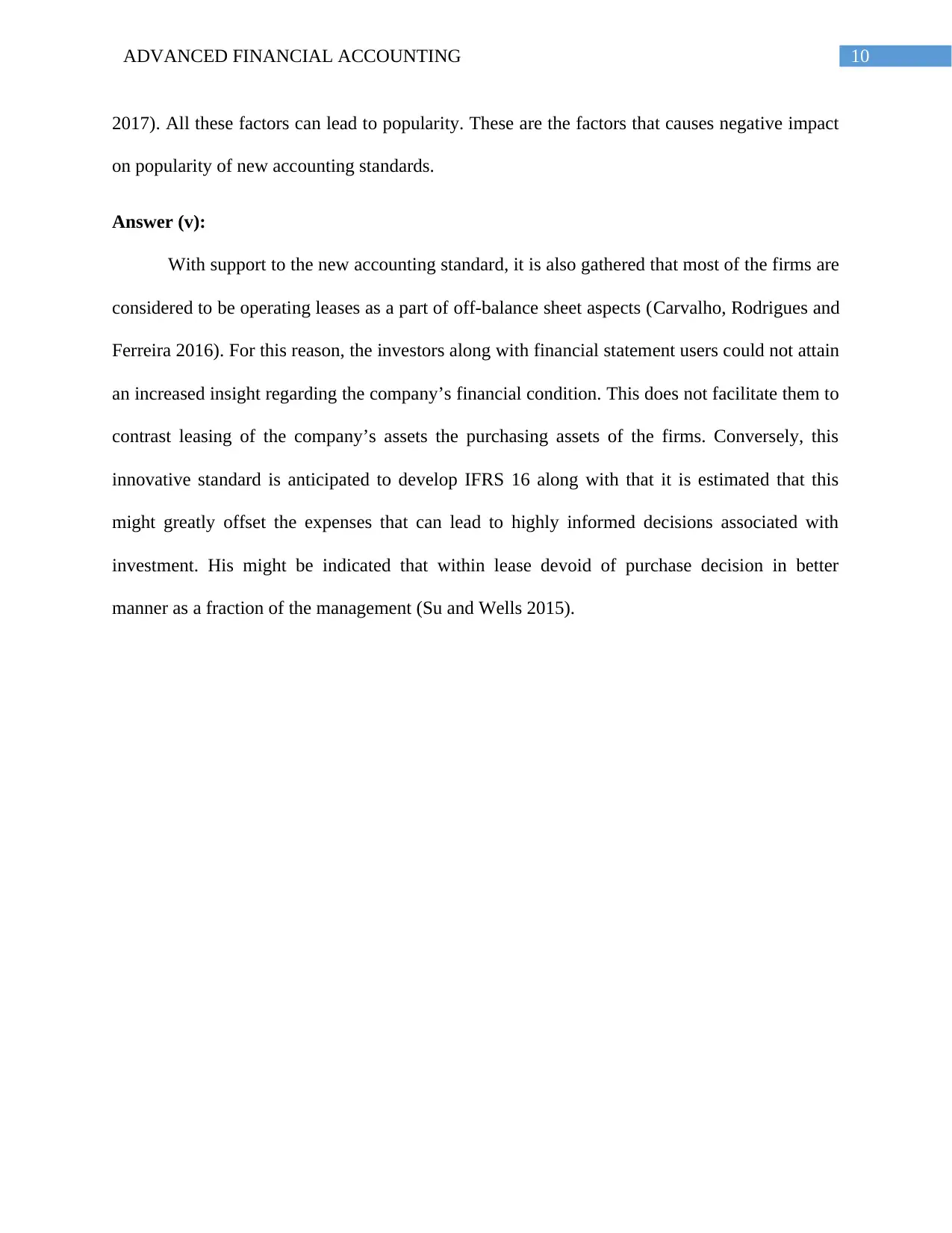
10ADVANCED FINANCIAL ACCOUNTING
2017). All these factors can lead to popularity. These are the factors that causes negative impact
on popularity of new accounting standards.
Answer (v):
With support to the new accounting standard, it is also gathered that most of the firms are
considered to be operating leases as a part of off-balance sheet aspects (Carvalho, Rodrigues and
Ferreira 2016). For this reason, the investors along with financial statement users could not attain
an increased insight regarding the company’s financial condition. This does not facilitate them to
contrast leasing of the company’s assets the purchasing assets of the firms. Conversely, this
innovative standard is anticipated to develop IFRS 16 along with that it is estimated that this
might greatly offset the expenses that can lead to highly informed decisions associated with
investment. His might be indicated that within lease devoid of purchase decision in better
manner as a fraction of the management (Su and Wells 2015).
2017). All these factors can lead to popularity. These are the factors that causes negative impact
on popularity of new accounting standards.
Answer (v):
With support to the new accounting standard, it is also gathered that most of the firms are
considered to be operating leases as a part of off-balance sheet aspects (Carvalho, Rodrigues and
Ferreira 2016). For this reason, the investors along with financial statement users could not attain
an increased insight regarding the company’s financial condition. This does not facilitate them to
contrast leasing of the company’s assets the purchasing assets of the firms. Conversely, this
innovative standard is anticipated to develop IFRS 16 along with that it is estimated that this
might greatly offset the expenses that can lead to highly informed decisions associated with
investment. His might be indicated that within lease devoid of purchase decision in better
manner as a fraction of the management (Su and Wells 2015).
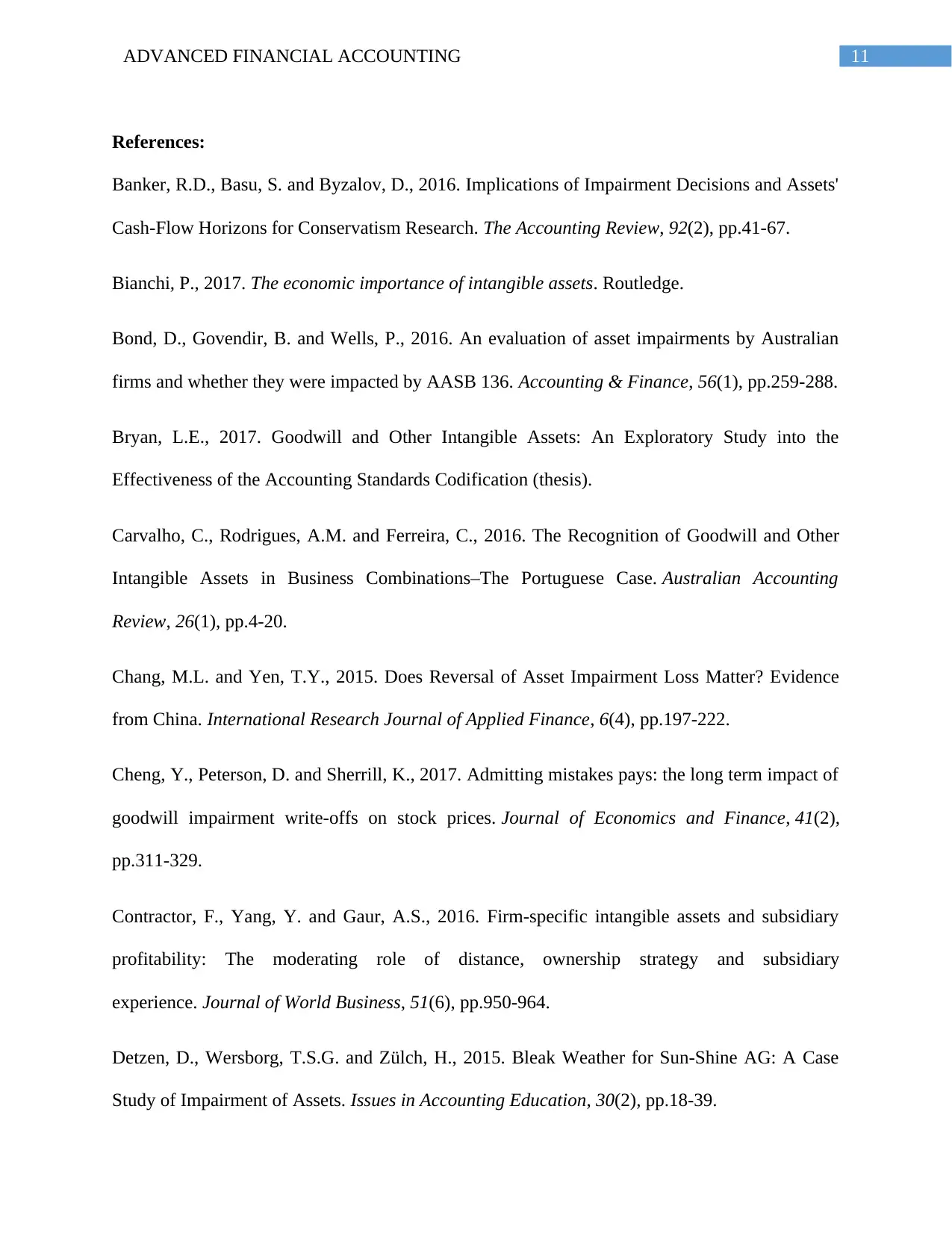
11ADVANCED FINANCIAL ACCOUNTING
References:
Banker, R.D., Basu, S. and Byzalov, D., 2016. Implications of Impairment Decisions and Assets'
Cash-Flow Horizons for Conservatism Research. The Accounting Review, 92(2), pp.41-67.
Bianchi, P., 2017. The economic importance of intangible assets. Routledge.
Bond, D., Govendir, B. and Wells, P., 2016. An evaluation of asset impairments by Australian
firms and whether they were impacted by AASB 136. Accounting & Finance, 56(1), pp.259-288.
Bryan, L.E., 2017. Goodwill and Other Intangible Assets: An Exploratory Study into the
Effectiveness of the Accounting Standards Codification (thesis).
Carvalho, C., Rodrigues, A.M. and Ferreira, C., 2016. The Recognition of Goodwill and Other
Intangible Assets in Business Combinations–The Portuguese Case. Australian Accounting
Review, 26(1), pp.4-20.
Chang, M.L. and Yen, T.Y., 2015. Does Reversal of Asset Impairment Loss Matter? Evidence
from China. International Research Journal of Applied Finance, 6(4), pp.197-222.
Cheng, Y., Peterson, D. and Sherrill, K., 2017. Admitting mistakes pays: the long term impact of
goodwill impairment write-offs on stock prices. Journal of Economics and Finance, 41(2),
pp.311-329.
Contractor, F., Yang, Y. and Gaur, A.S., 2016. Firm-specific intangible assets and subsidiary
profitability: The moderating role of distance, ownership strategy and subsidiary
experience. Journal of World Business, 51(6), pp.950-964.
Detzen, D., Wersborg, T.S.G. and Zülch, H., 2015. Bleak Weather for Sun-Shine AG: A Case
Study of Impairment of Assets. Issues in Accounting Education, 30(2), pp.18-39.
References:
Banker, R.D., Basu, S. and Byzalov, D., 2016. Implications of Impairment Decisions and Assets'
Cash-Flow Horizons for Conservatism Research. The Accounting Review, 92(2), pp.41-67.
Bianchi, P., 2017. The economic importance of intangible assets. Routledge.
Bond, D., Govendir, B. and Wells, P., 2016. An evaluation of asset impairments by Australian
firms and whether they were impacted by AASB 136. Accounting & Finance, 56(1), pp.259-288.
Bryan, L.E., 2017. Goodwill and Other Intangible Assets: An Exploratory Study into the
Effectiveness of the Accounting Standards Codification (thesis).
Carvalho, C., Rodrigues, A.M. and Ferreira, C., 2016. The Recognition of Goodwill and Other
Intangible Assets in Business Combinations–The Portuguese Case. Australian Accounting
Review, 26(1), pp.4-20.
Chang, M.L. and Yen, T.Y., 2015. Does Reversal of Asset Impairment Loss Matter? Evidence
from China. International Research Journal of Applied Finance, 6(4), pp.197-222.
Cheng, Y., Peterson, D. and Sherrill, K., 2017. Admitting mistakes pays: the long term impact of
goodwill impairment write-offs on stock prices. Journal of Economics and Finance, 41(2),
pp.311-329.
Contractor, F., Yang, Y. and Gaur, A.S., 2016. Firm-specific intangible assets and subsidiary
profitability: The moderating role of distance, ownership strategy and subsidiary
experience. Journal of World Business, 51(6), pp.950-964.
Detzen, D., Wersborg, T.S.G. and Zülch, H., 2015. Bleak Weather for Sun-Shine AG: A Case
Study of Impairment of Assets. Issues in Accounting Education, 30(2), pp.18-39.
⊘ This is a preview!⊘
Do you want full access?
Subscribe today to unlock all pages.

Trusted by 1+ million students worldwide
1 out of 14
Related Documents
Your All-in-One AI-Powered Toolkit for Academic Success.
+13062052269
info@desklib.com
Available 24*7 on WhatsApp / Email
![[object Object]](/_next/static/media/star-bottom.7253800d.svg)
Unlock your academic potential
Copyright © 2020–2025 A2Z Services. All Rights Reserved. Developed and managed by ZUCOL.





